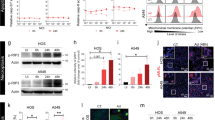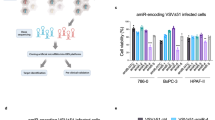Abstract
A major goal of molecular oncology is to identify means to kill cells lacking p53 function. Most current cancer therapy is based on damaging cellular DNA by irradiation or chemicals. Recent reports1,2 support the notion that, in the event of DNA damage, the p53 tumour-suppressor protein is able to prevent cell death by sustaining an arrest of the cell cycle at the G2 phase. We report here that adeno-associated virus (AAV) selectively induces apoptosis in cells that lack active p53. Cells with intact p53 activity are not killed but undergo arrest in the G2 phase of the cell cycle. This arrest is characterized by an increase in p53 activity and p21 levels and by the targeted destruction of CDC25C. Neither cell killing nor arrest depends upon AAV-encoded proteins. Rather, AAV DNA, which is single-stranded with hairpin structures at both ends3,4, elicits in cells a DNA damage response that, in the absence of active p53, leads to cell death. AAV inhibits tumour growth in mice. Thus viruses can be used to deliver DNA of unusual structure into cells to trigger a DNA damage response without damaging cellular DNA and to selectively eliminate those cells lacking p53 activity.
This is a preview of subscription content, access via your institution
Access options
Subscribe to this journal
Receive 51 print issues and online access
$199.00 per year
only $3.90 per issue
Buy this article
- Purchase on Springer Link
- Instant access to full article PDF
Prices may be subject to local taxes which are calculated during checkout



Similar content being viewed by others
References
Bunz, F. et al. Requirement for p53 and p21 to sustain G2 arrest after DNA damage. Science 282, 1497–1501 (1998).
Chan, T. A., Hermeking, H., Lengauer, C., Kinzler, K. W. & Vogelstein, B. 14-3-3σ is required to prevent mitotic catastrophe after DNA damage. Nature 401, 616–620 (1999).
Srivastava, A., Lusby, E. W. & Berns, K. I. Nucleotide sequence and organisation of the adeno-associated virus 2 genome. J. Virol. 45, 555–564 (1983).
Berns, K. I. & Linden, R. M. The cryptic life cycle of adeno-associated virus. Bioessays 17, 237–245 (1995).
Bowman, T. et al. Tissue specific inactivation of p53 tumour suppression in the mouse. Genes Dev. 10, 826–835 (1996).
Xiong, Y. et al. p21 is a universal inhibitor of cyclin-dependent kinases. Nature 366, 701–704 (1993).
Nurse, P. Universal control mechanism regulating cell cycle timing in M-phase. Nature 344, 503–508 (1990).
Strausfeld, U. et al. Activation of p34cdc2 protein kinase by microinjection of human CDC25C into mammalian cells. Requirement for prior phosphorylation of cdc25C by p34cdc2 on sites phosphorylated at mitosis. J. Biol. Chem. 269, 5989–6000 (1994).
Rock, K. et al. Inhibitors of the proteosome block the degradation of most cell proteins and the generation of peptides presented on MHC class I molecules. Cell 78, 761–771 (1994).
Wozniak, A. J. & Ross, W. E. DNA damage as a basis for 4′-demethylpipodophyllotoxin-9-(4,6-O-ethylidene-beta-D-glucopyronoside) (etoposide) cytotoxicity. Cancer Res. 43, 120–124 (1983).
Peng, C. Y. et al. Mitotic and G2 checkpoint control regulation of 14-3-3 protein binding by phosphorylation of CDC25C on serine-216. Science 277, 1501–1505 (1997).
Rotman, G. & Shiloh, Y. ATM: a mediator of multiple responses to genotoxic stress. Oncogene 18, 6135–6144 (1999).
Blasina, A., Price, D. D., Turenne, G. A. & Gowen, C. H. Caffeine inhibits the checkpoint kinase ATM. Curr. Biol. 9, 1135–1138 (1999).
Ruffing, M., Zentgraf, H. & Kleinschmidt, J. A. Assembly of viruslike particles by recombinant structural proteins of adeno-associated virus type 2 in insect cells. J. Virol. 66, 6922–6930 (1992).
Saudan, P., Vlach, J. & Beard, P. Inhibition of S-phase progression by adeno-associated virus is mediated by hypophosphorylated pRb. EMBO J. 19, 4351–4361 (2000).
Yang, D., van Boom, S. S., Reedijk, J., Farrell, N. & Wang, A. H. A novel DNA structure induced by the anticancer bisplatinum compound crosslinked to a GpC site in DNA. Nature Struct. Biol. 2, 577–578 (1995).
De La Maza, L. M. & Carter, B. J. Inhibition of adenovirus oncogenicity in hamsters by adeno-associated virus DNA. J. Natl Cancer Inst. 67, 1323–1326 (1981).
Finkel, E. Does cancer therapy trigger cell suicide? Science 286, 2256–2258 (1999).
Brown, J. M. & Wouters, B. G. Apoptosis, p53, and tumour cell sensitivity to anticancer agents. Cancer Res. 59, 1391–1399 (1999).
Beamish, H. & Lavin, M. F. Radiosensitivity in ataxia-talengiectasia: anomalies in radiation-induced cell cycle delay. Int. J. Radiat. Biol. 65, 175–184 (1994).
Ogston, P., Raj, K. & Beard, P. Productive replication of adeno-associated virus can occur in human papillomavirus type 16 (HPV16) episome-containing keratinocytes and is augmented by the HPV16 E2 protein. J. Virol. 74, 3494–3504 (2000).
Fournier, N. et al. Expression of human papillomavirus 16 E2 protein in Schizosaccharomyces pombe delays the initiation of mitosis. Oncogene 18, 4015–4021 (1999).
Acknowledgements
We thank N. Paduwat and B. Bentele for technical assistance; M. Chapman and X. Qing for the gift of AAV-2; B. Vogelstein for the HCT116 cell line and its derivatives; R. Iggo for antibodies and the Saos-2 and U2OS cell lines; M. Oren for p53DD vectors; A. M. R. Taylor for the ATM-null cells; K. Alevizopoulos for retroviral vectors; J. Kleinschmidt for recombinant baculovirus; C. Wenz for assistance in insect cell culture; and S. Gasser, A.-L. Ducrest, M. Höss, B. Hirt, J. Jiricny, R. Iggo and V. Simanis for discussions. B. Sordat and F. Hoffmann helped with the animal experiments, and P. Reichenbach and J. Wyniger with the micro-injection. This work was supported by Cancer Research Switzerland and the Swiss National Science Foundation.
Author information
Authors and Affiliations
Corresponding author
Supplementary information

Figure 1
(JPG 33.2 KB)
Effects of AAV-2 infection on osteosarcoma cells Schematic representation of AAV DNA. (a) Saos-2 cells (b-d) or U2OS cells (e-g) are shown either uninfected or after infection with AAV at a mul tiplicity of i fection (MOI) 5000. All photographs are at the same magnification.

Figure 2a
Effect of AAV on tumour formation (JPG 32.2 KB)
HCT116p53-/-or HCT116p53+/+cells (one million cells in 50 µl DMEM) were injected under the skin of both flanks of nude mice. Two days later the right flanks were injected with AAV (5X10 8 virus particles) while the left flanks were injected with PBS. Approximately 20 days later, the mice were examined for tumours. Examples of mice with HCT116p53-/-tumours (1 and 2)and HCT116p53+/+ tumours (3 and 4) are shown.

Figure 2b
Effect of AAV on established tumours (JPG 25.1 KB)
Tumours were induced in both flanks of nude mice by injecting either HCT116p53-/-ells or another p53-negative colon carcinoma cell line, HT29 (one million cells in 50 µl DMEM). After approximately 10 to 14 days, the tumours on the right flanks were injected with AAV (5x10 9virus particles) while tumours on the left flanks were injected with PBS on alternate days for 12 days. Examples of results with HT29 are shown. Mouse (1) is a control where tumours on both flanks were not injected. Mice (2-5) were injected as describe above. Tumours injected with AAV in mice 2 and 3 regressed completely while those of mice 4 and 5 grew more slowly in comparison to tumours injected with PBS.
Rights and permissions
About this article
Cite this article
Raj, K., Ogston, P. & Beard, P. Virus-mediated killing of cells that lack p53 activity. Nature 412, 914–917 (2001). https://doi.org/10.1038/35091082
Received:
Accepted:
Issue Date:
DOI: https://doi.org/10.1038/35091082
This article is cited by
-
A dual role for adeno-associated virus in human health
Virology Journal (2023)
-
Antiviral immunity and nucleic acid sensing in haematopoietic stem cell gene engineering
Gene Therapy (2021)
-
Tissue and cell-type-specific transduction using rAAV vectors in lung diseases
Journal of Molecular Medicine (2021)
-
Molecular Genetics and the Role of Molecularly Targeted Agents in Metastatic Colorectal Carcinoma
Journal of Gastrointestinal Cancer (2020)
-
Gorab is a Golgi protein required for structure and duplication of Drosophila centrioles
Nature Genetics (2018)
Comments
By submitting a comment you agree to abide by our Terms and Community Guidelines. If you find something abusive or that does not comply with our terms or guidelines please flag it as inappropriate.



